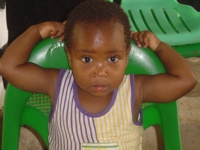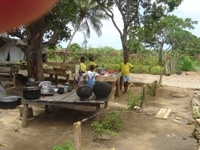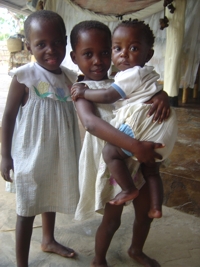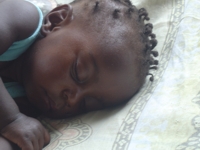Five year plan Imani 2006-2010
1. EXECUTIVE SUMMARY Imani five year plan 2006-2010
Imani Rehabilitation Centre, situated in the Kayole slum areas of Nairobi, was started in 1992, as a response and solution to the plight of the increasing number of street children in the capital city of Kenya. When it started, as an individual initiative, it did so at modest level, taking up about 15 children initially, offering them shelter, food, and love.
Over the years Imani has steadily grown, both in size and quality, moving from the individual initiative to a truly organization-based structure. It presently caters for an average of 250 – 350 children, now also and in particular including babies (abandoned, orphaned, neglected). Its services have become more professional, more focused yet all-inclusive, offering a comprehensive and complete mix of activities, which aims at giving the child a dignified existence while growing up, as well as a fair perspective for life. Imani is now one of the larger and more respected child rehabilitation centres in Kenya, often serving as a role model for others in similar activities.
Since its inception in 1992, the situation of street children in Nairobi has changed. While the number has grown considerably over the years, the Government of Kenya has initiated its own activities to respond to the situation, rather than leaving this to private initiative alone. It has set up reception centres where it initially houses the children before allocating them to children’s homes and rehabilitation schools around town, or to the National Youth Service.
Nevertheless, the relevance of Imani, and other organisations like it, has unfortunately only increased over the years. The Government can only absorb so many children, and does in particular not have enough specialized facilities to address the phenomenon of abandoned, orphaned, neglected and/or street babies (or in other words “the fruits of the street children”).
Recently, after more than twelve years of existence, the board, management and staff of Imani Rehabilitation Centre, together with relevant external stakeholders, have reflected on its history and where it stands today and should be in the future: its role in society, its capacities and its challenges.
This has resulted in the (re-)formulation of its vision, mission statement, overall objective, specific goals and, ultimately, its activities in a five-year plan (2006 – 2010), which are presented in this document.
Main outcome of the reflection exercise has been that Imani should build on its gained expertise, which now particularly includes the care for babies and small children upon intake (0-5 years of age mainly), which includes abandoned, orphaned (through HIV/Aids or otherwise) and neglected babies, as well as those for whom parental care has temporarily become void (mothers imprisoned, street mothers in rehabilitation). Meanwhile, the care and reintegration activities of in-house former CNCPs (Children in Need of Care and Protection) obviously remain an active objective as well, and will be improved upon, including education, health, rehabilitation and reintegration into society.
Imani expects to be catering for approximately 250 babies and children on average per year (refer to annex II: overview of estimated children/’s in/outflow 2006 – 2010), apart from a smaller number of drop-in children (children who have a home outside the centre where they sleep, but who can not be taken care of during time, mainly because of poverty); this may reach up to 100 children at maximum. The overview shows the expected shift over the coming years from the older street children to babies / infants (0-5 year olds will constitute 77 % of the total by 2010, whereas now it is 30 %). Two main reasons can be attributed to this shift: apart from the increased focus on babies, Imani will also, increasingly, hope to achieve that babies and children can leave Imani earlier and not spend their entire youths in the centre. This will be achieved through more active foster and adoption activities, rejoining with families or guardians. As a consequence the average age of the child will decrease.
Derived from the five year-plan is the budget, which is presented herein as well (annex III: detailed budget), broken down as per period (year) as well as per goals. The total budget for the planning period can be summarized as follows:
While Imani has always experienced a large and positive interest from donors, institutional and private alike, which remain to be actively involved in Imani, it is foreseen on basis of the included plan and budget, and commitments thus far, that for the years 2006 onwards further funding sources will be needed .
This document presents the detailed planning and related budget for the 2006 – 2010 period. At the same time it includes an outline of the legal and organizational setting of Imani itself, as it is today or will be in the near future, highlighting, it hopes, that a solid base for implementing its plans has been created. With this, Imani believes that it has presented a sound justification for its plans and funding request.
Imani Rehabilitation Centre hopes that the plan will generate the interest of donors to such an extent that it will be able to implement these plans successfully. Anticipating a positive response, it wishes, on behalf of the children and, by extension, Kenyan society as a whole -as ultimate beneficiaries-, to thank all of those who show a tangible interest.
At the same time, Imani wishes to wholeheartedly thank all of those who have shown interest and contributed towards its success over the past fifteen years, including both institutional as well as individual donors and supporters. A comprehensive list of these over the years is annexed to this document (annex V). We are looking forward to a continued relationship. We can not do what we do without you.
In case you are interested to receive a copy of the full 5-year plan, please send an e-mail request to info@stichtingimani.nl.
|




|



